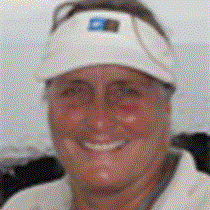Genovesa
We spent the last day of June on the magical island of Genovesa. Before breakfast, naturalist Fernando led a group of eager kayakers along the base of the steep cliffs inside the sunken caldera of Darwin Bay. They were drenched by a brief shower but in spite of the damp had a marvelous outing during which they saw many seabirds and sea lions and they thoroughly enjoyed working up an appetite while paddling along. Some of the kayakers spotted a large manta ray!
After breakfast the sun came out and we made a wet landing on a small coral beach and were immediately amazed by the number of seabirds nesting, roosting, and flying in this area! Frigate birds (a few with their red pouches inflated and still hoping to find a mate) and red-footed boobies were on their nests in the low shrubs; Nazca boobies and swallow-tailed gulls had nests and chicks on the ground. Hundreds of frigates and boobies soared on the constant breeze and sea lions lounged on the sand and in the waves. Some of us continued on along the trail across rough lava to a viewpoint over the bay where this morning the waves were choppy due to the fresh and persistent breeze.
Back at the beach some returned to the ship to suit-up for a final snorkeling outing and a few of us swam and then relaxed on the sand. We watched as a female frigate fed the hungry juvenile and were amazed that the chick stuffed his bill inside the mother’s mouth up to his eye! Two Zodiacs of snorkelers swam along at the base of the cliffs and enjoyed seeing many colorful fish and a few fur seals. By now–this was our fifth snorkeling outing–we have begun to recognize many of the more common species of fish, like the king angels, yellow-tailed razor fish, Moorish idols, large-banded blennies, rainbow wrasse, blue-chin parrot fish among others.
By afternoon it had again clouded over so we hiked in cool and breezy weather. Fernando took a group of “do-it-all” folks off for a fast walk at Prince Phillips Steps followed by a paddle in the kayaks back to the ship. They found their owl on the fast walk and paddled past sea turtles and fur seals on their return along the base of the cliffs.
At 1600 Aura and Sofia lead the rest of us up the steep and rustic steps and across the point of the island to search for petrels and short -eared owls. We identified large cactus and small ground finches, and admired the many fluffy baby frigates in their nests and the much larger juvenile Nazca boobies. Out on the flat lava flow many storm petrels were swooping around and disappearing into their nest holes—most were the Maderian or wedge-rumped (also called Galápagos) storm petrels. We found several of the well camouflaged short-eared owls that were hunting these numerous petrels.
We returned to the ship contentedly, knowing that we have shared an amazing experience this week. The Galápagos archipelago is one of the last groups of islands on our beautiful planet with an intact ecosystem, and we feel privileged to have spent a week exploring this unique place. It has been especially fun for all of us—crew, staff and guests alike—to travel with such an interesting and like-minded group of guests who are entwined via deep mutual friendship and respect.




